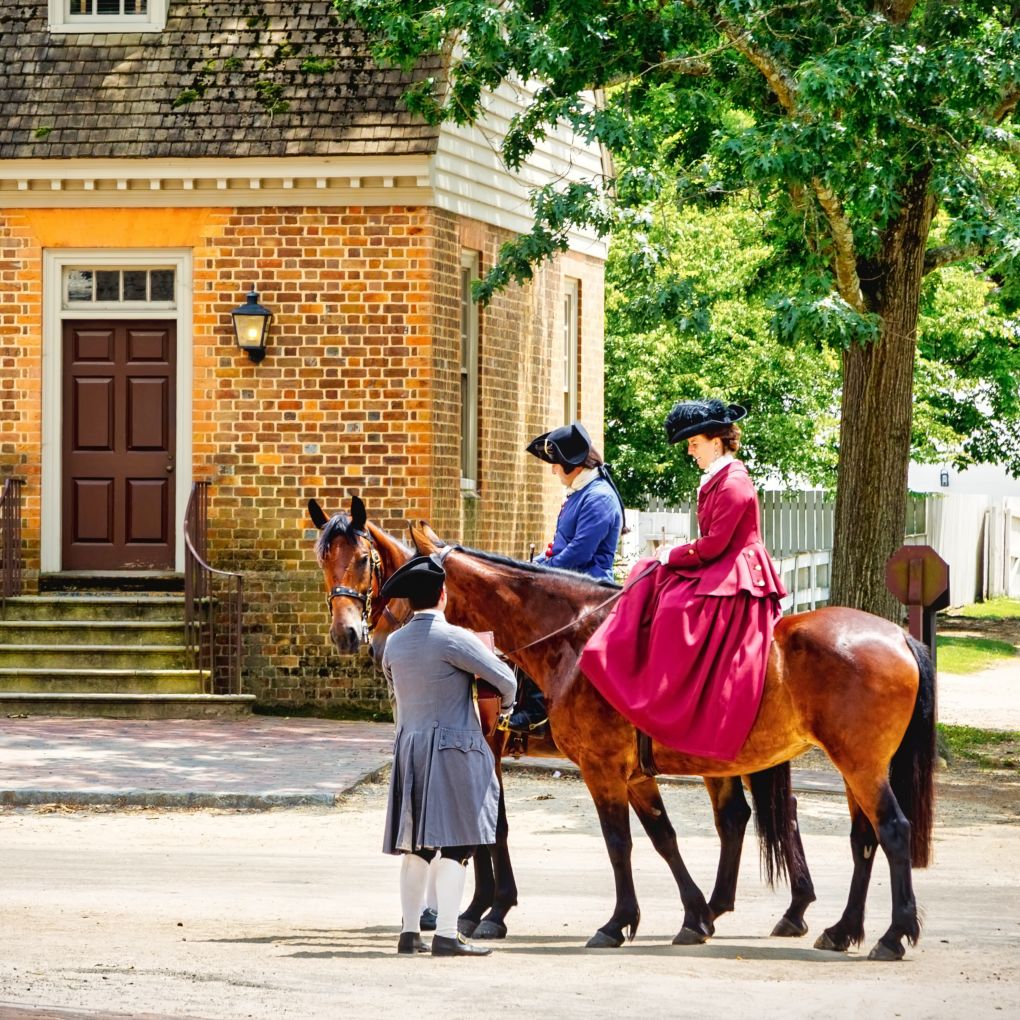Reading a history book is a great way to learn about our nation’s rich past, and watching a history-based movie or TV show can be even more enjoyable and just as educational. But there’s nothing like seeing a national landmark, historical location, or important battle site with your own eyes to learn the lessons of history in a personal, profound, and lasting way.
Here are ten incredible locations to visit, from sea to shining sea, that encapsulate the breadth and depth of American history. From Boston to San Francisco, from colonial times to World War II, trips to these ten locations offer the opportunity to learn about revolution, independence, civil war, immigration, what life was like in times past, and the values that tie us together as Americans.
Colonial Williamsburg, Virginia
Subject/time period: Colonial period, 18th century
A visit to Colonial Williamsburg (pictured above) is like stepping into the past. The historic district is an authentic restoration and replication of life in the 18th century, complete with many buildings that are hundreds of years old, cobblestone streets, and actor-interpreters dressed in period costumes who interact with visitors and demonstrate skills and crafts from the time period. It’s a wonderful destination for children and adults alike, featuring a unique way to learn about life and historical events of our country during the pre-Revolutionary period.
Fascinating Facts
Williamsburg was a center of education. The College of William & Mary, founded in 1693, is the second oldest institution of higher learning in the United States, and it was already nearly a century old during the revolutionary period.

Gettysburg, Pennsylvania
Subject/time period: Civil War, 1860s
Website: Destination Gettysburg
A trip to Gettysburg, PA is an up-close-and-personal opportunity to learn about the Battle of Gettysburg, which happened from July 1 to July 3, 1863, and is considered the turning point of the Civil War in favor of the Union Army. It was the largest and bloodiest battle fought on American soil to date, resulting in the loss of approximately 50,000 soldiers on both sides. In his famous Gettysburg Address in November of that year, Abraham Lincoln promised that “these dead shall not have died in vain” and that “a government of the people, by the people, for the people, shall not perish from the earth.”
Fascinating Facts
One civilian was killed during the Battle of Gettysburg: Ginnie Wade, a 20-year-old woman who was making bread when a stray bullet passed through her kitchen door and struck her.

Freedom Trail, Boston, Massachusetts
Subject/time period: Revolutionary period, 18th century, and beyond
Website: The Freedom Trail
Boston is one of the nation’s oldest cities and one of the most important cities of the Revolutionary War. The 2.5-mile-long Freedom Trail starts at Boston Common and makes its way through the heart of the city past 16 historically significant buildings and sites including Faneuil Hall and the USS Constitution. Walking this trail is a chance to learn about important events in the Revolutionary War period, including the Boston Massacre, the Boston Tea Party, Paul Revere’s midnight ride, and the history of Boston and the U.S. in the years that followed.
Fascinating Facts
According to popular legend, Paul Revere rode through the streets yelling, “The British are coming!” But this phrase is likely an oversimplification or even a myth. During the time, most colonists still considered themselves British, so it would have been confusing to say “The British are coming.” It’s more likely that Revere warned about the regulars (a term for British soldiers) or said something like, “The Regulars are coming out.” He also didn’t complete his ride alone, but other riders went out that night to deliver the same message.

Alamo Mission, San Antonio, Texas
Subject/time period: Texas Revolution (Texas War for Independence), 1835-1836
Website: The Alamo
The Battle of the Alamo, February 23 to March 6, 1836, was a fight for independence for Texas from Mexico. Davy Crockett and Jim Bowie were among the 200 or so who, for 13 days, successfully defended the Alamo building against General Santa Anna’s Mexican army of thousands. Ultimately, they lost – and Crockett, Bowie, and the other Texians lost their lives – but “Remember the Alamo” is still a powerful call today to remember the courage and tenacity of the men who fought so hard for independence.
Fascinating Facts
The Alamo began as the Mission San Antonio de Valero long before it was used as a fort. It was constructed by Spanish missionaries in the early 18th century to convert local Native Americans to Christianity. Later, it was used as a military outpost by the Spanish, Mexicans, and Texans.

Ellis Island and Statue of Liberty, New York City, New York
Subject/time period: Immigration, 19th and early 20th century
Website: Ellis Island | Statue of Liberty
Approximately 12 million people passed through Ellis Island during its heyday from 1892-1954 for immigration processing, an important step towards starting a new life in a new country. Today, Ellis Island houses an interactive museum that gives a glimpse into the reality of Ellis Island, how different waves of immigration contributed to the multicultural melting pot of America and the stories of many of the people who came here. Immigrants sailing into New York Harbor on their way to be processed at Ellis Island would have been greeted by the Statue of Liberty, a symbol of freedom and democracy, on nearby Liberty Island.
Fascinating Facts
The original Ellis Island was quite small, encompassing only about three acres. To accommodate the growing immigration station, the island was expanded over time with landfill, eventually reaching its present size of 27.5 acres. Some of the materials used for this expansion included rubble from the construction of the New York City subway system.

Monticello, Charlottesville, Virginia
Subject/time period: Thomas Jefferson, 1743-1826
Website: Thomas Jefferson’s Monticello
Monticello is the name of the plantation home of Thomas Jefferson, the third President of the U.S. and principal author of the Declaration of Independence. The 11,000-square-foot Neoclassical building was designed by Jefferson himself and sits on approximately 2,600 acres (about 4 square miles) of land. Today, the house is a UNESCO World Heritage Site and museum where people can learn about Jefferson’s life, the founding of the country, and Monticello itself including the free and enslaved individuals who lived and worked there.
Fascinating Facts
Jefferson packed Monticello with various inventions and innovative features. These included a clock he designed (which had the days of the week on it), dumbwaiters for wine bottles, a revolving bookstand that could hold five books at once, and a “Great Clock” visible from both inside and outside the house. Jefferson was constantly thinking about ways to improve daily life and the functionality of his home.

Mount Rushmore, South Dakota
Subject/time period: Mount Rushmore and the four presidents
Website: Mount Rushmore National Memorial
The four faces of George Washington, Thomas Jefferson, Abraham Lincoln, and Theodore Roosevelt carved into the granite face of Mount Rushmore are each 60 feet high, as tall as a 6-story building. The impressive undertaking began in 1927 and was completed 14 years later, in 1941. Visitors to Mount Rushmore can see the sculptures from the Grand View Terrace, walk the Presidential Trail for a different view, learn about the creation of the iconic monument in the Sculptor’s Studio, explore the landscape and nature of the surrounding Black Hills, and more.
Fascinating Facts
The scale of Mount Rushmore is larger than many people realize. Each of the presidential heads is about 60 feet tall. The noses are 20 feet long, the mouths 18 feet wide, and the eyes 11 feet across.

San Francisco’s Historic Landmarks, California
Subject/time period: San Francisco, multiple time periods
Website: San Francisco Travel
San Francisco is home to a number of historic landmarks that contribute to the richness of the city and the nation. A few notable landmarks: The Golden Gate Bridge, a feat of engineering and the largest suspension bridge in the world when it opened in 1937; the city’s iconic cable cars, in operation since the late 19th century; Alcatraz Island, the site of a former federal prison and current museum; and Chinatown, the oldest Chinatown in the U.S. and a symbol of Asian immigration to the U.S. via the West Coast.
Fascinating Facts
After the federal prison closed in 1963, Alcatraz was occupied by Native American activists from 1969 to 1971. They claimed the land based on the Treaty of Fort Laramie (1868), which stated that unused federal land should be returned to the Native people from whom it was acquired. The occupation, although it ended without the activists’ demands being met, is often seen as a turning point in the Native American rights movement.

Santa Fe Historic District, New Mexico
Subject/time period: Santa Fe, multiple time periods
Website: TOURISM Santa Fe
Santa Fe was founded in 1610 as the capital of the “Kingdom of New Mexico,” over two hundred years before becoming a U.S. territory in 1848 at the conclusion of the Mexican-American War. Today, visitors to the city’s Historic District can learn about its culturally diverse heritage, with history and culture shaped by Spanish, Mexican, and Native American forces and influences. The city is also known for its art scene, traditional adobe architecture, and beautiful surroundings.
Fascinating Facts
The Palace of the Governors in Santa Fe is considered the oldest continuously occupied public building in the United States. It was built around 1610 as Spain’s seat of government for what is today the American Southwest.

Pearl Harbor, Hawaii
Subject/time period: Attack on Pearl Harbor and U.S. involvement in WWII, 1941-1945
Website: Pearl Harbor National Memorial
Shortly before 8 am on December 7, 1941, Japanese forces mounted a surprise attack on the U.S. Pacific Fleet at Pearl Harbor, killing 2,403 Americans and wounding 1,178 more. This shocking event marked the start of the official U.S. involvement in World War II, changing the course of the war and world history. Visitors to Pearl Harbor can learn about the attack and WWII at the Visitor Center, as well as learn about the fate of the sunken USS Arizona and its men.
Fascinating Facts
The attack on Pearl Harbor was particularly shocking because Japan did not formally declare war on the U.S. before the attack commenced. A 14-part message breaking off relations was supposed to be delivered to the U.S. government before the attack began, but due to issues with decoding and typing the message, it wasn’t delivered until well after the attack had started. This led President Franklin D. Roosevelt to refer to the attack as “a date which will live in infamy.”




